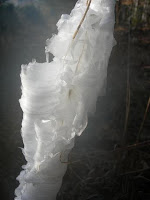|
Jen
Expedition Leader
    
1384 Posts
Jennifer
Calico Rock
AR
USA
1384 Posts |
 Posted - Nov 20 2007 : 7:01:54 PM Posted - Nov 20 2007 : 7:01:54 PM



|
Have you ever seen these gossamer frost formations? They're called frost flowers, and they're beautiful! My hub took this picturerecently & I've since spotted a bunch on frosty mornings.

Here's a bit more about them from http://en.wikipedia.org/wiki/Frost_flowers:
"Frost flowers is the name commonly given to a condition in which thin layers of ice are extruded from long-stemmed plants in autumn or early winter. The thin layers of ice are often formed into exquisite patterns that curl into "petals" that resemble flowers.
The formation of frost flowers, also known as "ice flowers," is apparently dependent on a freezing weather condition occurring when the ground is not already frozen. The sap in the stem of the plants will expand (water expands when frozen), causing long, thin cracks to form along the length of the stem. Water is then drawn through these cracks via capillary action and freezes upon contact with the air. As more water is drawn through the cracks it pushes the thin ice layers further from the stem, causing a thin "petal" to form. In the case of woody plants and tree branches the freezing water is squeezed through the pores of the plant forming long thin strings of ice that look uncannily like hair ie: 'frost beard'.
The petals of frost flowers are very delicate and will break when touched. They usually melt or sublimate when exposed to sunlight and are usually visible in the early morning or in shaded areas.
Examples of plants that form frost flowers are white crownbeard (Verbesina virginica), commonly called frostweed, yellow ironweed (Verbesina alternifolia), and Helianthemum canadense. The have also have been observed growing from fallen branches of conifers and contain enough hydraulic power to strip the bark off."
The View From My Boots: www.bovesboots.blogspot.com
|
|